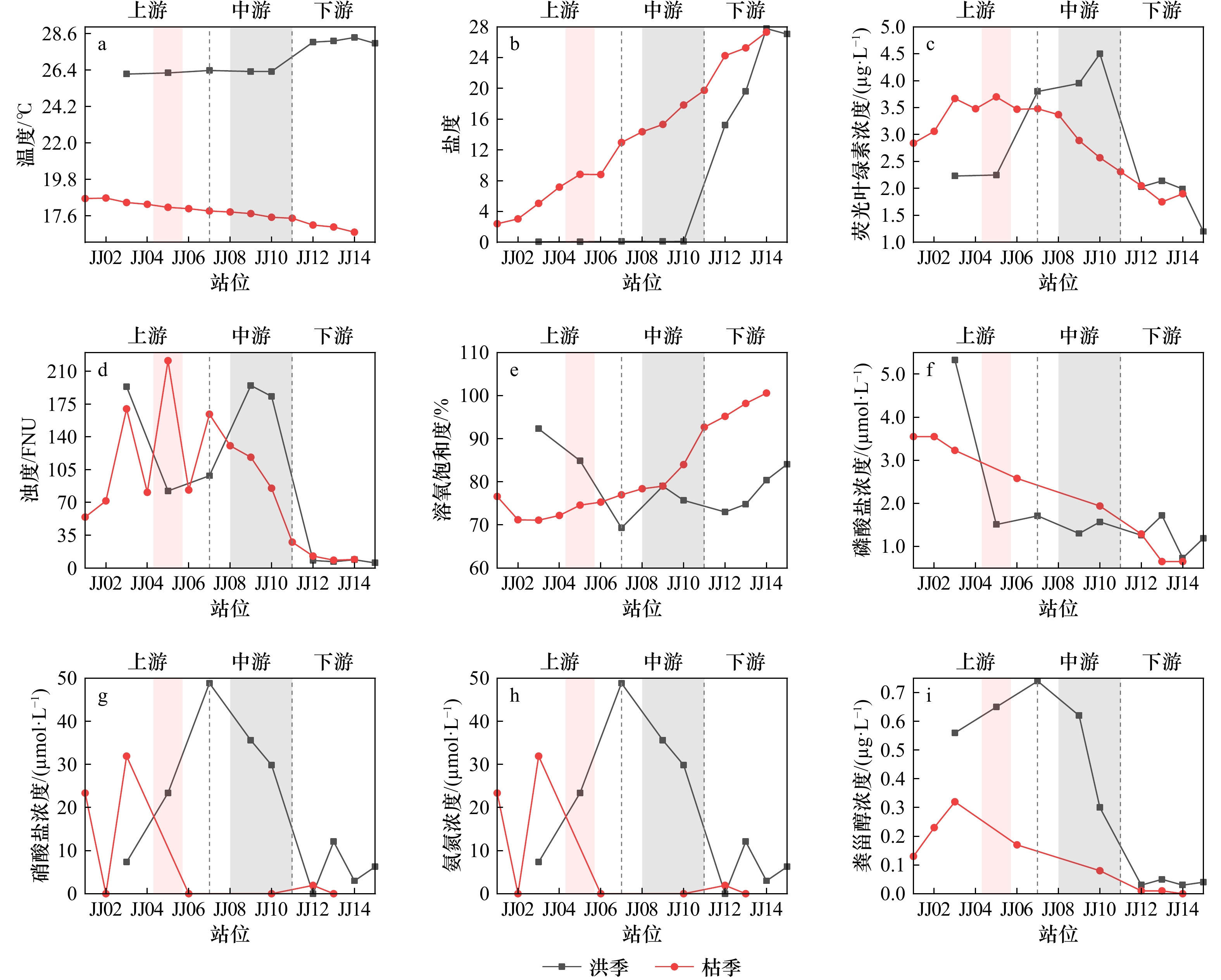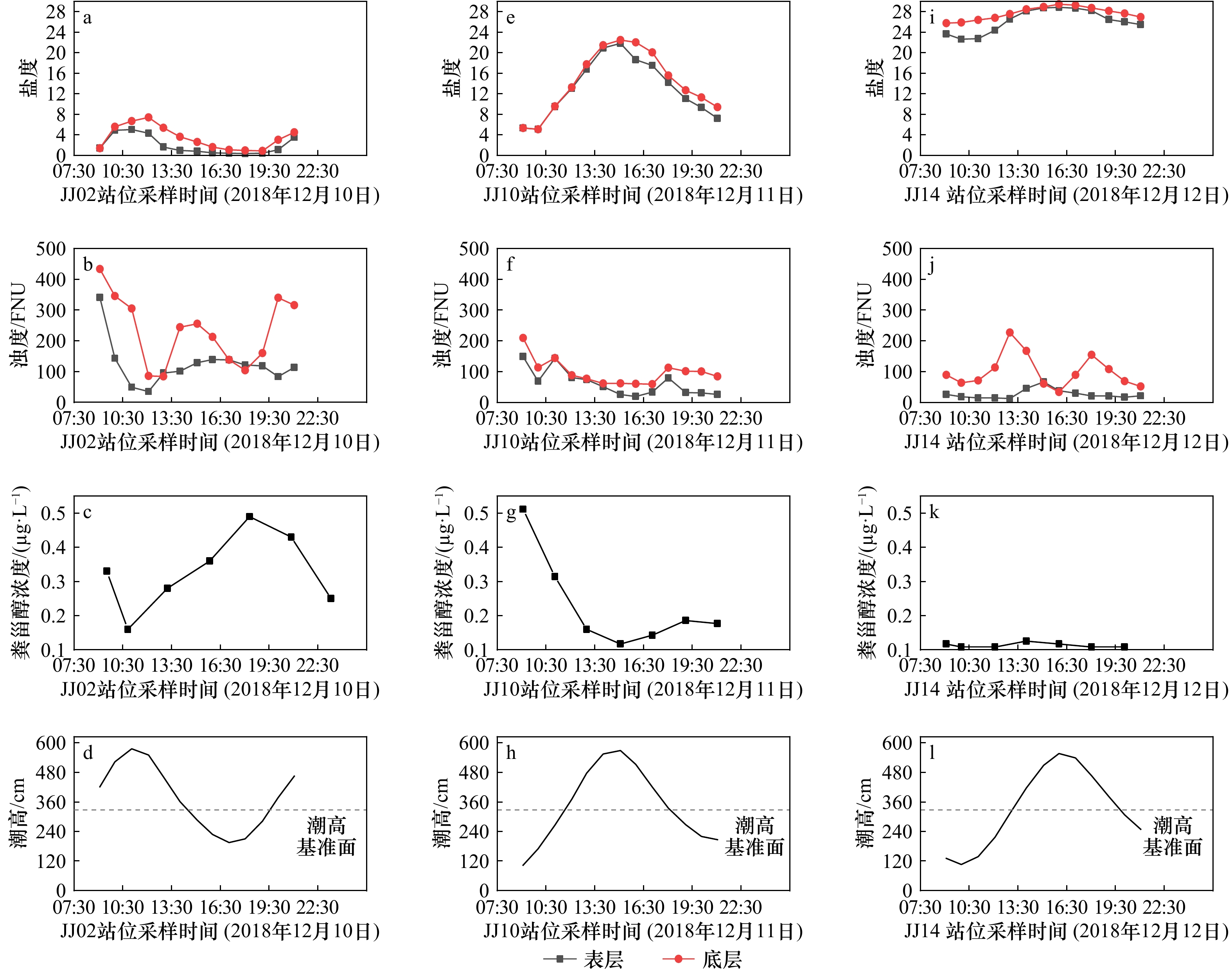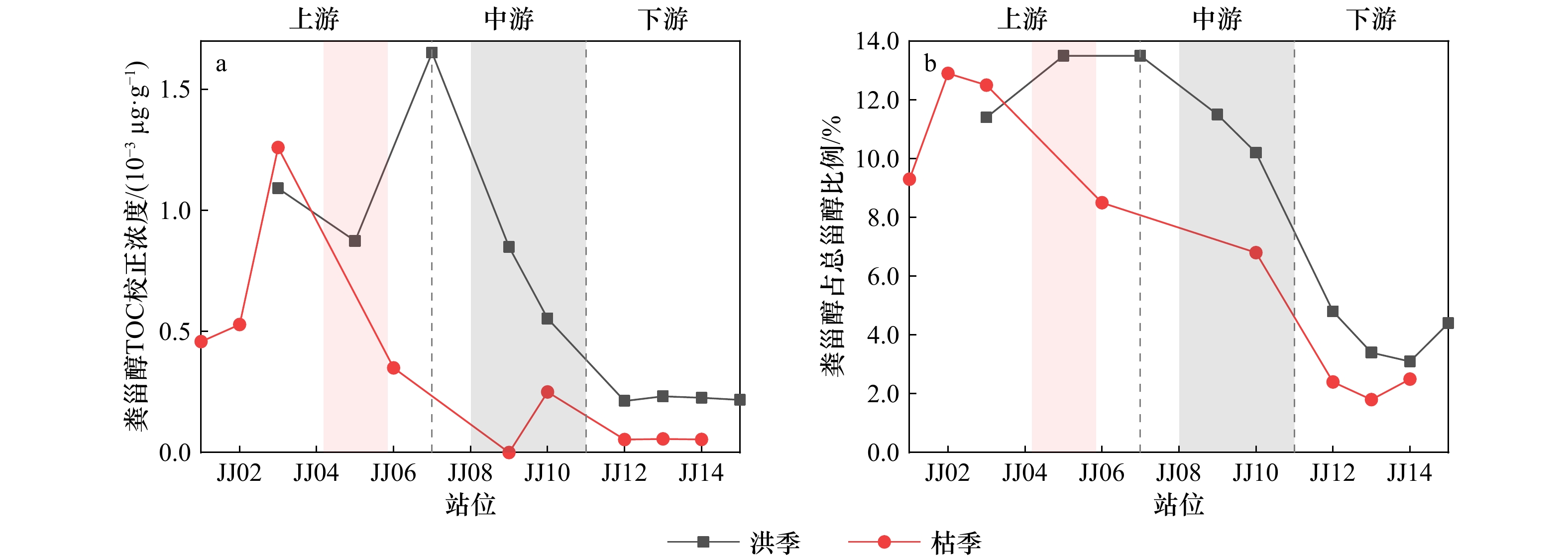Decipher temporal and spatial variation characteristics of fecal organic matter pollution by the coprostanol in the Jiulong River Estuary
-
摘要: 河口是陆源污染物入海的主要通道,在全球气候快速变化和人类活动加剧的背景下,河流入海污染物通量急剧增加,导致河口、海湾及其周边海域水体污染、生态受损等严峻的环境问题发生。本文选取了受极端事件和人类活动影响显著的我国东南强潮型的九龙江河口,利用粪甾醇有机标志物手段开展河口环境粪类污染示踪研究,探讨九龙江河口区粪类污染物(“源”)进入河流后的入海行为(“到”),揭示粪类有机质在近河口海域时空分布特征及受控因素(“汇”)。研究发现,不同季节的河口径流过程和潮汐作用影响粪类有机污染物的时空分布,潮汐过程对中上游河口区水体环境中粪甾醇的赋存影响较大,呈现高潮低浓度而低潮高浓度的潮周期变化特征;河口区粪甾醇在陆−海输运过程的赋存特征还受控于最大浑浊带复杂的水体和沉积动力过程,对粪类有机污染物有一定的净化作用;研究还通过对比人为源贡献主导的氨氮等河流输入的营养盐说明粪甾醇在河口区的时空分布特征与人类活动密切相关。Abstract: Estuaries are the main channels for land-derived pollutants to enter the sea. Under the background of rapid global climate change and intensified human activities, the flux of river pollutants into the sea has increased sharply, resulting in serious ecological problems such as water pollution and ecological damage in estuaries, bays and their adjacent marginal seas. This paper selects the Jiulong River Estuary, which is significantly affected by strong tides, extreme events and human activities, and applied a biomarker tool−coprostanol to trace the environmental fecal pollution, explore the enter the sea behavior (“to”) of fecal pollutants (“source”) in the Jiulong River Estuary after entering the river, and reveal the spatial and temporal distribution characteristics and controlled factors (“sink”) of fecal organic matter within the estuary. The study found that the estuarine runoff process and tidal action in different seasons affect the spatial and temporal distribution of fecal organic pollutants, and the tidal process has a greater impact on the occurrence of coprostanol in the water environment of the middle and upper reaches of the estuary, showing a tidal cycle of low concentration at high tide and high concentration at low tide. The occurrence characteristics of coprostanol in the land-sea transport process in the estuarine area are also controlled by the complex water body and sediment dynamic process in the maximum turbidity zone, which has a certain purification effect on fecal organic pollutants. The study also shows that the spatiotemporal distribution characteristics of coprostanol in estuarine areas are closely related to human activities by comparing the nutrient inputs from rivers such as ammonia and nitrogen dominated by anthropogenic contributions.
-
Key words:
- coprostanol /
- Jiulong River Estuary /
- turbidity maximum /
- fecal organic pollution
-
图 2 2018−2019年九龙江河口断面洪季(8月)和枯季(2月)典型月份表层水环境参数、营养盐和粪甾醇浓度特征分布
红色阴影部分代表枯季最大浑浊带影响区,灰色阴影部分代表洪季最大浑浊带影响区
Fig. 2 Spatial distributions of surface water environment parameters and nutrients and coprostanol concentration of Jiulong River Estuary section in typical months of flood (August) and dry (February) seasons from 2018 to 2019
The red and gray shaded areas represent the areas affected by the maximum turbidity zone during the dry and flood seasons, respectively
图 4 2018−2019年九龙江河口断面洪季(8月)和枯季(2月)典型月份表层海水悬浮颗粒物中粪甾醇丰度和粪甾醇占总甾醇比例分布
红色阴影部分代表枯季最大浑浊带影响区;灰色阴影部分代表洪季最大浑浊带影响区
Fig. 4 Distribution map of TOC normalized coprostanol abundance and proportion of coprostanol to total sterols in suspended particulate matter of surface seawater in typical months in flood season (August) and dry season (February) of Jiulong River Estuary section from 2018 to 2019
The red and gray shaded areas represent the areas affected by the maximum turbidity zone during the dry and flood seasons, respectively
表 1 九龙江河口水环境参数和营养盐变化范围
Tab. 1 Variation range of water environmental parameters and nutrients in the Jiulong River Estuary
参数 洪季断面表层 枯季断面表层 JJ02站位定点 JJ10站位定点 JJ14站位定点 表层 底层 表层 底层 表层 底层 温度/℃ 26.2~28.4 16.6~18.7 盐度 0.06~27.78 2.41~27.31 0.37~5.05 0.87~7.41 5.12~21.83 5.09~22.48 22.64~28.85 25.78~29.46 荧光叶绿素浓度/(μg·L−1) 1.2~4.5 1.8~3.7 浊度/FNU 5.4~194.9 8.4~221.4 35.5~340.7 84.9~433.4 19.4~148.9 59.6~209.5 12.6~66.7 34.1~227.1 溶氧饱和度/% 69.3~92.3 71.1~100.6 磷酸盐浓度/(μmol·L−1) 0.7~5.3 0.7~3.6 硝酸盐浓度/(μmol·L−1) 38.4~119.4 7.7~142.9 氨氮浓度/(μmol·L−1) 0~48.9 0~31.9 表 3 九龙江河口粪甾醇浓度与其他地区的比较
Tab. 3 Comparison of coprostanol concentration in the Jiulong River Estuary with other areas
表 2 2018−2019年九龙江河口断面洪季(8月)和枯季(2月)典型月份主要参数相关系数
Tab. 2 The pearson correlations of relevant parameters in surface water at Jiulong River Estuary section in typical months in flood season (August) and dry season (February) from 2018 to 2019
参数 粪甾醇/
(μg·L−1)温度/
℃盐度 荧光叶绿素浓度/
(μg·L−1)浊度/
FNU溶氧饱和度/
%磷酸盐/
(μmol·L−1)硝酸盐/
(μmol·L−1)氨氮/
(μmol·L−1)粪甾醇/(μg·L−1) 1 0.325 −0.801** 0.451 0.733** −0.206 0.331 0.557* 0.738** 温度/℃ 0.325 1 −0.175 0.086 0.082 −0.400 −0.104 0.224 0.274 盐度 −0.801** −0.175 1 −0.710** −0.771** 0.508* −0.611** −0.854** −0.645** 荧光叶绿素浓度/(μg·L−1) 0.451 0.086 −0.710** 1 0.593** −0.711** 0.258 0.548* 0.593* 浊度/FNU 0.733** 0.082 −0.771** 0.593** 1 −0.165 0.518* 0.553* 0.562* 溶氧饱和度/% −0.206 −0.400 0.508* −0.711** −0.165 1 −0.247 −0.614** −0.369 磷酸盐/(μmol·L−1) 0.331 −0.104 −0.611** 0.258 0.518* −0.247 1 0.625** 0.027 硝酸盐/(μmol·L−1) 0.557* 0.224 −0.854** 0.548* 0.553* −0.614** 0.625** 1 0.486* 氨氮/(μmol·L−1) 0.738** 0.274 −0.645** 0.593* 0.562* −0.369 0.027 0.486* 1 注:**p< 0.01,相关性极显著;*p< 0.05级别,相关性显著。 -
[1] 张少峰, 刘国强, 魏春雷. 粪大肠菌群检测方法及研究进展[J]. 海洋通报, 2008, 27(3): 102−106. doi: 10.3969/j.issn.1001-6392.2008.03.016Zhang Shaofeng, Liu Guoqiang, Wei Chunlei. Test methods and research progress in fecal coliforms[J]. Marine Science Bulletin, 2008, 27(3): 102−106. doi: 10.3969/j.issn.1001-6392.2008.03.016 [2] 冯春明. 环境水体中粪大肠菌群检测方法研究进展[J]. 广东化工, 2015, 42(12): 107−108. doi: 10.3969/j.issn.1007-1865.2015.12.052Feng Chunming. Research progress on detection methods of fecal coliform in environmental water[J]. Guangdong Chemical Industry, 2015, 42(12): 107−108. doi: 10.3969/j.issn.1007-1865.2015.12.052 [3] Leeming R, Ball A, Ashbolt N, et al. Using faecal sterols from humans and animals to distinguish faecal pollution in receiving waters[J]. Water Research, 1996, 30(12): 2893−2900. doi: 10.1016/S0043-1354(96)00011-5 [4] Campos V, Fracácio R, Fraceto L F, et al. Fecal sterols in estuarine sediments as markers of sewage contamination in the Cubatão area, São Paulo, Brazil[J]. Aquatic Geochemistry, 2012, 18(5): 433−443. doi: 10.1007/s10498-012-9167-2 [5] Writer J H, Leenheer J A, Barber L B, et al. Sewage contamination in the upper Mississippi River as measured by the fecal sterol, coprostanol[J]. Water Research, 1995, 29(6): 1427−1436. doi: 10.1016/0043-1354(94)00304-P [6] 马海青, 冯环, 王旭晨. 渤海湾和胶州湾表层沉积物中甾醇的分布和来源[J]. 海洋科学, 2009, 33(6): 73−79, 85.Ma Haiqing, Feng Huan, Wang Xuchen. Distribution and sources of sterols in surface sediments from Bohai Bay and Jiaozhou Bay[J]. Marine Sciences, 2009, 33(6): 73−79, 85. [7] 徐恒振, 刘星, 姚子伟. 粪固醇作为海洋环境中粪便污染指示物的研究[J]. 海洋环境科学, 2010, 29(6): 777−780. doi: 10.3969/j.issn.1007-6336.2010.06.001Xu Hengzhen, Liu Xing, Yao Ziwei. Faecal sterols as an indicator of pollution feces in marine environment[J]. Marine Environmental Science, 2010, 29(6): 777−780. doi: 10.3969/j.issn.1007-6336.2010.06.001 [8] Al-Omran L A G. Coprostanol in the intertidal sediments of Kuwait. Case study on urban sewage contamination[J]. International Journal of Environmental Studies, 1998, 55(1/2): 87−100. [9] Green G, Skerratt J H, Leeming R, et al. Hydrocarbon and coprostanol levels in seawater, sea-ice algae and sediments near Davis Station in Eastern Antarctica: a regional survey and preliminary results for a field fuel spill experiment[J]. Marine Pollution Bulletin, 1992, 25(9/12): 293−302. [10] Jeng W L, Wang J, Han B C. Coprostanol distribution in marine sediments off southwestern Taiwan[J]. Environmental Pollution, 1996, 94(1): 47−52. doi: 10.1016/S0269-7491(96)00101-7 [11] 张玉珍, 洪华生, 曾悦, 等. 九龙江流域畜禽养殖业的生态环境问题及防治对策探讨[J]. 重庆环境科学, 2003, 25(7): 29−31, 34.Zhang Yuzhen, Hong Huasheng, Zeng Yue, et al. The environmental problems of livestock raising and its countermeasures in Jiulongjiang Watershed[J]. Chongqing Environmental Science, 2003, 25(7): 29−31, 34. [12] 洪华生, 曾悦, 张珞平, 等. 九龙江流域畜牧养殖系统的氮磷流失研究[J]. 厦门大学学报(自然科学版), 2004, 43(4): 542−546.Hong Huasheng, Zeng Yue, Zhang Luoping, et al. Nutrient losses of livestock farms in Jiulong River Watershed[J]. Journal of Xiamen University (Natural Science), 2004, 43(4): 542−546. [13] Gu Chao, Li Hong, Xu Fanghua, et al. Numerical study of Jiulongjiang River plume in the wet season 2015[J]. Regional Studies in Marine Science, 2018, 24: 82−96. doi: 10.1016/j.rsma.2018.07.004 [14] 中国海湾志编纂委员会. 中国海湾志·第十四分册·重要河口[M]. 北京: 海洋出版社, 1998.China Bay Record Committee. China Bays-Key Estuaries, Volume 14[M]. Beijing: China Ocean Press, 1998. [15] 中国人民解放军海军司令部航海保证部. 潮汐表[Z]. 东海海区, 2008.The Navigation Guarantee Department of the Chinese Navy Headquarters. Tide table East China Sea Coast[Z]. East China Sea Coast, 2008. [16] Tao Shuqin, Eglinton T I, Montluçon D B, et al. Pre-aged soil organic carbon as a major component of the Yellow River suspended load: regional significance and global relevance[J]. Earth and Planetary Science Letters, 2015, 414: 77−86. doi: 10.1016/j.jpgl.2015.01.004 [17] 李春初. 中国南方河口过程与演变规律[M]. 北京: 科学出版社, 2004: 248.Li Chunchu. The Process and Evolution of Estuaries in Southern China[M]. Beijing: Science Press, 2004: 248. [18] 沈焕庭, 朱建荣, 吴华林. 长江河口陆海相互作用界面[M]. 北京: 海洋出版社, 2009: 210.Shen Huanting, Zhu Jianrong, Wu Hualin, et al. Interfaces of Ocean-Land Interaction in the Changjiang Estuary[M]. Beijing: China Ocean Press, 2009: 210. [19] 洪雄业. 厦门湾营养盐长期动态变化与陆源污染关系分析[J]. 应用海洋学学报, 2022, 41(2): 249−258. doi: 10.3969/J.ISSN.2095-4972.2022.02.009Hong Xiongye. Analysis of the long-term dynamics of nutrients linking to terrestrial pollution in Xiamen Bay[J]. Journal of Applied Oceanography, 2022, 41(2): 249−258. doi: 10.3969/J.ISSN.2095-4972.2022.02.009 [20] 罗颖, 金海燕, 李德望, 等. 夏季洪水对长江口及邻近海域颗粒有机碳分布与来源的影响[J]. 海洋学研究, 2021, 39(4): 73−81. doi: 10.3969/j.issn.1001-909X.2021.04.007Luo Ying, Jin Haiyan, Li Dewang, et al. Impacts of summer floods on the distribution and source of particulate organic carbon in the Changjiang (Yangtze River) Estuary and its adjacent sea area[J]. Journal of Marine Sciences, 2021, 39(4): 73−81. doi: 10.3969/j.issn.1001-909X.2021.04.007 [21] 王安月. 夏季长江口水体可溶有机质的组成及其空间展布特征[D]. 杭州: 浙江大学, 2021.Wang Anyue. Composition and spatial distribution of dissolved organic matter in summer water from the Yangtze River Estuary[D]. Hangzhou: Zhejiang University, 2021. [22] 李志宏. 2017年厦门市海洋环境状况公报[M]. 厦门: 方志出版社, 2018: 465-474.Li Zhihong. 2017 Bulletin of Xiamen Marine Eco-environmental Status[M]. Xiamen: Fangzhi Publishing House, 2018: 465−474. [23] 施震. 珠江口最大浑浊带活动区生源要素特征及浮游生物生态效应[D]. 广州: 南海海洋研究所, 2013.Shi Zhen. Characteristics of biogenic elements and their ecological effects on plankton in turbidity maximum of the Pearl River Estuary, South China[D]. Guangzhou: South China Sea Institute of Oceanology, 2013. [24] 刘四光, 高爱国, 陈岚, 等. 闽江河口咸淡水混合过程中营养盐含量的变化特征[J]. 台湾海峡, 2012, 31(3): 345−352.Liu Siguang, Gao Aiguo, Chen Lan, et al. Variation characteristics of nutrient content in the process of fresh and salt water mixing in Minjiang Estuary[J]. Journal of Oceanography in Taiwan Strait, 2012, 31(3): 345−352. [25] Komada T, Reimers C E. Resuspension-induced partitioning of organic carbon between solid and solution phases from a river–ocean transition[J]. Marine Chemistry, 2001, 76(3): 155−174. doi: 10.1016/S0304-4203(01)00055-X [26] Middelburg J J. Reviews and syntheses: to the bottom of carbon processing at the seafloor[J]. Biogeosciences, 2018, 15(2): 413−427. doi: 10.5194/bg-15-413-2018 [27] Bouloubassi I, Fillaux J, Saliot A. Hydrocarbons in surface sediments from the Changjiang (Yangtze River) Estuary, East China Sea[J]. Marine Pollution Bulletin, 2001, 42(12): 1335−1346. doi: 10.1016/S0025-326X(01)00149-7 [28] 邹良荣. 九龙江流域及河口有机δ13C和C/N特征及其对POM物源与运移过程的指示意义[D]. 厦门: 厦门大学, 2018.Zou Liangrong. Characteristics of bulk organic δ13C and C/N in Jiulong River and estuary and it’s indication for the sources and transport of POM[D]. Xiamen: Xiamen University, 2018. [29] 颜秀利, 翟惟东, 洪华生, 等. 九龙江口营养盐的分布、通量及其年代际变化[J]. 科学通报, 2012, 57(18): 2307−2318. doi: 10.1007/s11434-012-5084-4Yan Xiuli, Zhai Weidong, Hong Huasheng, et al. Distribution, fluxes and decadal changes of nutrients in the Jiulong River Estuary, Southwest Taiwan Strait[J]. Chinese Science Bulletin, 2012, 57(18): 2307−2318. doi: 10.1007/s11434-012-5084-4 [30] 曾金凤. 东江源区氨氮指标浓度时空变化及影响因素分析[J]. 人民珠江, 2015, 36(4): 79−84. doi: 10.3969/j.issn.1001-9235.2015.04.024Zeng Jinfeng. Analysis on spatial-temporal variation and influencing factors of ammonia nitrogen index concentration in the source area of Dongjiang River[J]. Pearl River, 2015, 36(4): 79−84. doi: 10.3969/j.issn.1001-9235.2015.04.024 [31] 蔡锋, 黄敏芬, 苏贤泽, 等. 九龙江河口湾泥沙运移特点与沉积动力机制[J]. 台湾海峡, 1999, 18(4): 418−424.Cai Feng, Huang Minfen, Su Xianze, et al. Characteristics of silt movement and sedimentary dynamic mechanism in Jiulongjiang Estuary[J]. Journal of Oceanography in Taiwan Strait, 1999, 18(4): 418−424. [32] Saiz-Salinas J, González-Oreja J. Coprostanol levels and organic enrichment in sediments of the Bilbao Estuary (north of Spain)[J]. Oceanologica Acta, 1998, 21(2): 319−324. doi: 10.1016/S0399-1784(98)80018-2 -





 下载:
下载:




